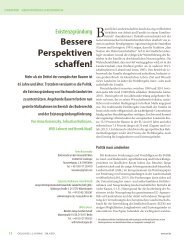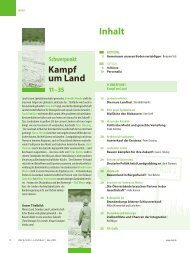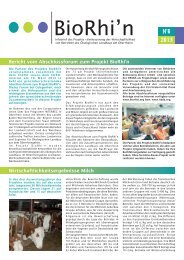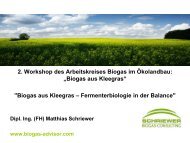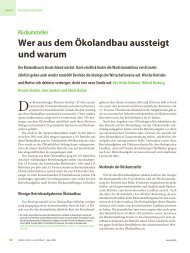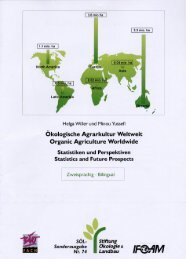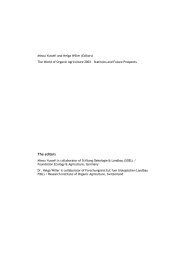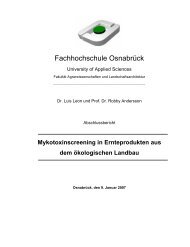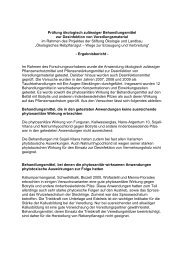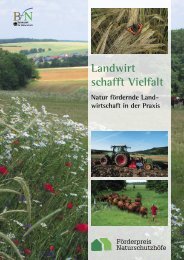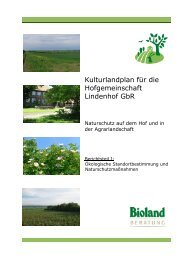the world of organic agriculture - Organic Eprints
the world of organic agriculture - Organic Eprints
the world of organic agriculture - Organic Eprints
Create successful ePaper yourself
Turn your PDF publications into a flip-book with our unique Google optimized e-Paper software.
7 Crop Information and Statistics<br />
5000 and 6000 metric tons 6 <strong>of</strong> <strong>organic</strong> milds; about 2’000 tons <strong>of</strong> <strong>organic</strong> natural arabica are<br />
being produced in Ethiopia, Tanzania and Uganda. The last two countries and Madagascar<br />
produce between 1000 and 1’500 tons <strong>of</strong> <strong>organic</strong> robustas.<br />
In Asia, according to <strong>the</strong> last <strong>organic</strong> c<strong>of</strong>fee conference held in Uganda in 2004, East Timor is <strong>the</strong><br />
largest producer, with 9’000 metric tons <strong>of</strong> <strong>organic</strong> green c<strong>of</strong>fee, although it only sells 2000 tons<br />
as <strong>organic</strong>. Unfortunately, data on <strong>organic</strong> certified land area was not available for this country<br />
or for o<strong>the</strong>r important countries like Vietnam or Papua New Guinea that produce <strong>organic</strong> milds<br />
in Asia. According to this survey, Indonesia is <strong>the</strong> <strong>world</strong>’s third largest <strong>organic</strong> c<strong>of</strong>fee producer,<br />
however, <strong>the</strong> figure is quite old (1998). Concerning <strong>the</strong> robustas, India is <strong>the</strong> main <strong>organic</strong><br />
producer in Asia with an estimated 500 tons in 2004 (CIMS).<br />
The strengths and <strong>the</strong> weaknesses <strong>of</strong> <strong>organic</strong> c<strong>of</strong>fee production were discussed in <strong>the</strong> last IFOAM<br />
<strong>Organic</strong> C<strong>of</strong>fee Conference held in Uganda in October 2004. As <strong>the</strong> participants pointed out,<br />
<strong>organic</strong> c<strong>of</strong>fee production has a lot <strong>of</strong> opportunities ahead. Its cultivation includes valuable<br />
environmental and social services that consumers are ready to pay for.<br />
However, <strong>organic</strong> c<strong>of</strong>fee cannot completely solve <strong>the</strong> problems <strong>of</strong> <strong>the</strong> general crises in <strong>the</strong> c<strong>of</strong>fee<br />
market, and <strong>the</strong>re are still a lot <strong>of</strong> problems to be solved. The most important ones were discussed<br />
in Uganda, and included amongst o<strong>the</strong>rs, <strong>the</strong> lack <strong>of</strong> harmonization in <strong>the</strong> <strong>organic</strong> certification<br />
sector; <strong>the</strong> need for an increased share <strong>of</strong> <strong>the</strong> c<strong>of</strong>fee price going to <strong>the</strong> producers; and <strong>the</strong> threat<br />
that policies promoting practices contrary to <strong>organic</strong> such as genetic engineering (GMOs) and<br />
pesticides involve.<br />
Websites<br />
• Fair-trade Labeling Organization International. Homepage: www.fairtrade.net/index.<br />
html<br />
• International C<strong>of</strong>fee Organization. www.ico.org<br />
Bibliography<br />
Kilcher et al. 2002. <strong>Organic</strong> C<strong>of</strong>fee, cocoa and tea. Market, certification and production information for producers and<br />
international trading companies. Switzerland.<br />
Proceedings <strong>of</strong> <strong>the</strong> Third International IFOAM <strong>Organic</strong> C<strong>of</strong>fee Conference. Kampala, Uganda. October 6-8, 2004.<br />
Organized by <strong>the</strong> Uganda C<strong>of</strong>fee Development Authority and endorsed by <strong>the</strong> International C<strong>of</strong>fee Organization<br />
(ICO).<br />
Introduction to <strong>the</strong> First Regional Round Table on Sustainable <strong>Organic</strong> and Specialty C<strong>of</strong>fee, Production Processing<br />
and Marketing. By K.R. Chapman, Plant Production Officer (Industrial Crops) FAO Regional Office for<br />
Asia and <strong>the</strong> Pacific, Bangkok. Thailand http://www.fao.org/<strong>organic</strong>ag/doc/<strong>organic</strong>_c<strong>of</strong>fee.htm<br />
6 CIMS estimations, 2004. 3rd International IFOAM <strong>Organic</strong> C<strong>of</strong>fee Conference. Uganda, 2004.<br />
57



